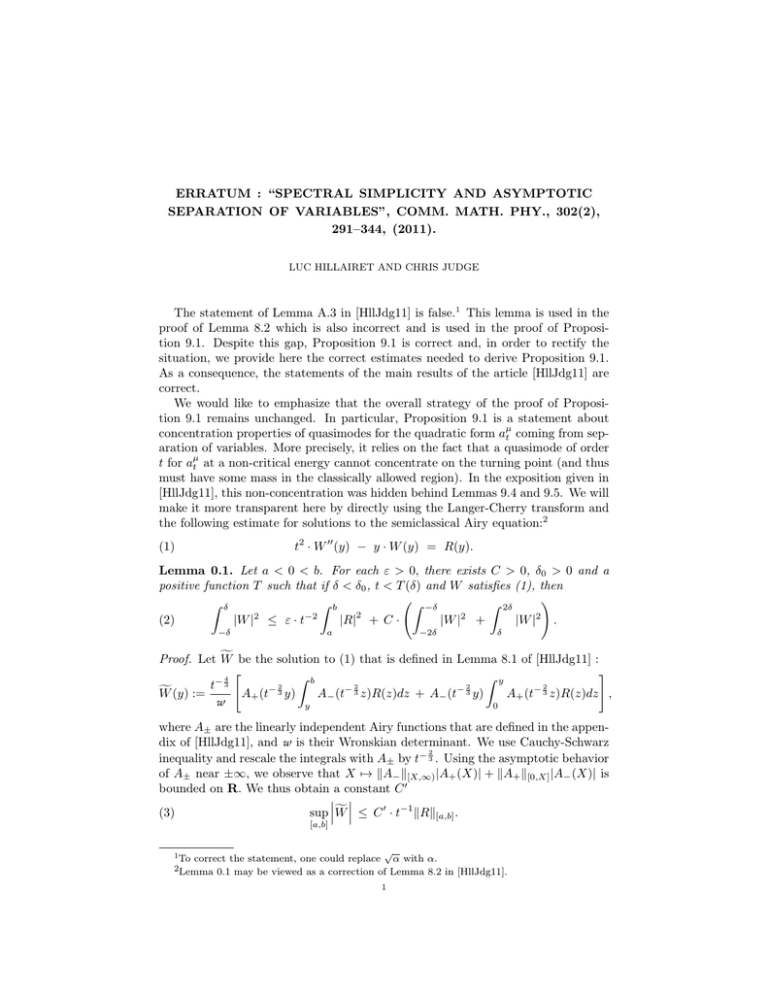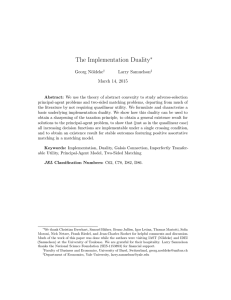ERRATUM : “SPECTRAL SIMPLICITY AND ASYMPTOTIC 291–344, (2011).
advertisement

ERRATUM : “SPECTRAL SIMPLICITY AND ASYMPTOTIC
SEPARATION OF VARIABLES”, COMM. MATH. PHY., 302(2),
291–344, (2011).
LUC HILLAIRET AND CHRIS JUDGE
The statement of Lemma A.3 in [HllJdg11] is false.1 This lemma is used in the
proof of Lemma 8.2 which is also incorrect and is used in the proof of Proposition 9.1. Despite this gap, Proposition 9.1 is correct and, in order to rectify the
situation, we provide here the correct estimates needed to derive Proposition 9.1.
As a consequence, the statements of the main results of the article [HllJdg11] are
correct.
We would like to emphasize that the overall strategy of the proof of Proposition 9.1 remains unchanged. In particular, Proposition 9.1 is a statement about
concentration properties of quasimodes for the quadratic form aµt coming from separation of variables. More precisely, it relies on the fact that a quasimode of order
t for aµt at a non-critical energy cannot concentrate on the turning point (and thus
must have some mass in the classically allowed region). In the exposition given in
[HllJdg11], this non-concentration was hidden behind Lemmas 9.4 and 9.5. We will
make it more transparent here by directly using the Langer-Cherry transform and
the following estimate for solutions to the semiclassical Airy equation:2
t2 · W 00 (y) − y · W (y) = R(y).
(1)
Lemma 0.1. Let a < 0 < b. For each ε > 0, there exists C > 0, δ0 > 0 and a
positive function T such that if δ < δ0 , t < T (δ) and W satisfies (1), then
!
Z δ
Z b
Z −δ
Z 2δ
2
2
−2
2
2
(2)
|W | ≤ ε · t
|R| + C ·
|W | +
|W | .
−δ
−2δ
a
δ
f be the solution to (1) that is defined in Lemma 8.1 of [HllJdg11] :
Proof. Let W
"
#
Z b
Z y
− 34
2
2
2
2
t
−
−
−
−
f (y) :=
W
A+ (t 3 y)
A− (t 3 z)R(z)dz + A− (t 3 y)
A+ (t 3 z)R(z)dz ,
w
y
0
where A± are the linearly independent Airy functions that are defined in the appendix of [HllJdg11], and w is their Wronskian determinant. We use Cauchy-Schwarz
2
inequality and rescale the integrals with A± by t− 3 . Using the asymptotic behavior
of A± near ±∞, we observe that X 7→ kA− k[X,∞) |A+ (X)| + kA+ k[0,X] |A− (X)| is
bounded on R. We thus obtain a constant C 0
f
(3)
sup W
≤ C 0 · t−1 kRk[a,b] .
[a,b]
1
To correct the statement, one could replace
√
α with α.
2Lemma 0.1 may be viewed as a correction of Lemma 8.2 in [HllJdg11].
1
2
LUC HILLAIRET AND CHRIS JUDGE
The rescaled difference A(x) =
f
W −W
2 t 3 · x is a solution to the Airy
equation A00 (x) − x · A(x) = 0. Using estimates for Airy functions in the same
manner as in the proof of Lemma A.4 of [HllJdg11]—but with greater care on how
the constant depends on a and b—we find a constant C > 0 that is independent of
δ and a positive function t0 such that, for any δ > 0 and any t < t0 (δ) and for any
A which is a solution to Airy’s equation, then
!
Z −δ Z 2δ Z δ 2
2
2
2
2
2
(4)
A t− 3 y dy +
A t− 3 y dy .
A t− 3 y dy ≤ C ·
−2δ
−δ
δ
The desired estimate (2) then follows from straightforward estimations: Use the
f |2 +|W
f |2 ). The second term is estimated by integrating
inequality |W |2 ≤ 2(|W − W
f |2 , then
(3) over [−δ, δ]. To bound the first term, first apply estimate (4) to |W − W
2
2
2
f | ≤ 2(|W | + |W
f | ), and finally apply (3) integrated over
use the inequality |W − W
the intervals [−2δ, −δ] and [δ, 2δ]. Since estimate (3) is integrated over intervals of
width δ, the prefactor results from choosing δ0 small enough.
µ
Proposition 0.2. Given a compact set K ⊂ σ(0)
, ∞ and C > 0, there exist
positive constants C 0 , s0 and t0 such that if 0 < t < t0 , E ∈ K and for each v we
have
(5)
|aµt (w, v) − E · hw, viσ | ≤ C · t · kwkσ · kvkσ ,
then
kwk2σ
≤ C
0
Z
−s0
xE
2
|w(x)| dx.
0
Proof. Let WE denote the Langer-Cherry transform of w at energy E, and let
φE : [0, ∞) → R denote the associated change of variables (see §7 in [HllJdg11]).
Let a = 21 sup{φE (0) | E ∈ K}. For each E ∈ K, there exists sE > 0 so that
E
a = φE x−s
. Let b = sup{φE (xsEE ) | E ∈ K}.
E
By Proposition 7.3 in [HllJdg11], WE satisfies (1) on [a, b] with a right-hand
side RE that can be estimated using Lemma 7.5. Using the latter lemma, the
assumptions on w, and Lemma 6.23, we get the following bound
Z b
(6)
|RE (y)|2 dy ≤ C · t2 · kwk2σ .
a
By Lemma 7.4 in [HllJdg11] and using the compactness of K, there exists M > 0
so that for each interval I ⊂ [a, b]
Z
Z
Z
−1
2
2
(7)
M
|w| dx ≤
|WE | dy ≤ M
|w|2 dx.
φ−1
E (I)
I
φ−1
E (I)
Using Lemma 0.1 and (6) and choosing ε small enough, we find δ0 , C and a positive
function T such that, for any δ < δ0 and any t ≤ T (δ) we have
Z
Z
1
2
2
|w(x)| σ(x)dx ≤ kwkσ + C ·
|w(x)|2 σ(x)dx,
−1
4
c)
φ−1
([−δ,δ])
φ
([−δ,δ]
E
E
3In Lemma 6.2, the integral on the right can be replaced by the integral from 0 to xs . This
E
allows us to put the weight σ on both sides.
ERRATUM
3
c
where we have set [−δ, δ] := [a, b]\[−δ, δ]. We choose δ = δ20 and fix some s0 such
s0
−s0
s0
−1
−1
c
0
that φE ([x−s
E , xE ] ⊂ ] − δ, δ[. Since [xE , xE ] ⊂ φE ([−δ, δ]) and φE ([−δ, δ] ) ⊂
−s0
s0
R\(xE , xE ), we obtain the following estimate :
Z xsE0
Z
1
2
2
|w(x)| σ(x)dx ≤ kwkσ + C ·
|w(x)|2 σ(x)dx
−s
−s
s
4
xE 0
R\(xE 0 ,xE0 )
The claim now follows in a quite standard way: We split the integral defining
−s0
s0
s0
0
kwk2σ into three parts : [0, x−s
E ], [xE , xE ] and [xE , ∞). We use the preceding
bound for the second integral and we use Lemma 6.2 to bound each integral over
[xsE0 , ∞). We obtain the following estimate
Z x−s
0
E
1
2
2
+ C · t kwkσ + (C + 1) ·
|w(x)|2 σ(x)dx.
kwkσ ≤
4
0
For t small enough, the term kwk2σ on the right can be absorbed on the left. The
claim follows since σ is bounded.
Proof of Proposition 9.1 in [HllJdg11]. It suffices to prove that there exists κ > 0
so that under the assumptions of Proposition 0.2 we have
Z ∞
2
(8)
(E · σ(x) − µ) · |w(x)| dx ≥ κ · kwk2σ .
0
Let s0 , t0 be as in Proposition 0.2. For any s < s0 , split the integral on the left of
−s0
−s
−s
s
0
(8) into the integrals corresponding to the intervals [0, x−s
E ], [xE , xE ], [xE , xE ],
s
and [xE , ∞). Observe that the integral over the second interval is positive. This
yields the following lower bound :
Z ∞
Z x−s
Z ∞
0
E
2
(E · σ(x) − µ) · |w(x)| dx ≥ s0
|w(x)|2 dx − 2Cskwk2σ − C
|w(x)|2 dx.
0
xsE
0
s0
2
C 0 kwkσ ,
where C 0 is the
By Proposition 0.2, the first term is bounded below by
constant in Proposition 0.2. We choose s small enough so that the second term is
s0
2
bounded below by − 4C
0 kwkσ and we choose t small enough so that, using Lemma
6.2, the third is term is also bounded by the latter quantity. The claim follows with
κ = s0 /2C 0 .
References
[HllJdg11] L. Hillairet and C. Judge. Spectral simplicity and asymptotic separation of variables.
Comm. Math. Phy., 302(2),291–344, 2011.









